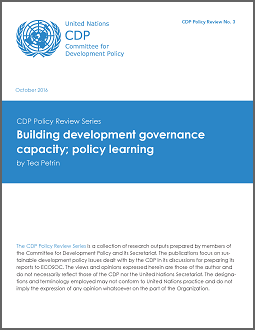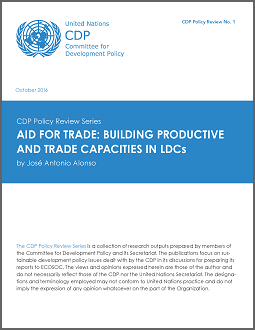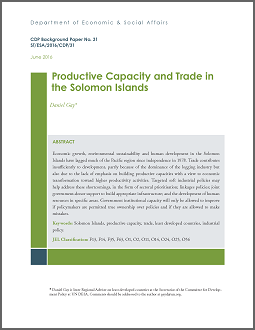Document_CDP: LDC Publications
LDC Publications
12 April 2017
This paper examines the process of building productive capacity in Ethiopia over the past two decades and the roles played by the state, government, the private sector, foreign firms and development partners.
26 October 2016
CDP Policy Review No. 5 By Keith Nurse The paper reviews the provisions within the WTO multilateral trade regime which impact on the policy space for LDCs which are interested in pursuing industrial policies as latecomers. It finds that LDCs are more c ...
25 October 2016
CDP Policy Review No. 4 By Stephan Klasen, Inmaculada Martínez-Zarzoso, Felicitas Nowak-Lehmann and Matthias Bruckner The paper investigates the effectiveness of trade preferences for LDCs. It confirms that overall trade preferences for LDCs increase L ...
24 October 2016
CDP Policy Review No. 3 By Tea Petrin The paper overviews the evidence of good governance institutional reform agenda on the development outcomes of LDCs. For building development governance capacity in LDC for achieving sustainable development goals, ...
23 October 2016
CDP Policy Review No. 2 By Keun Lee The paper discusses two ways of building productive capacity in LDCs: the manufacture of products to foreign buyers’ specifications, and the integration of resource-based sectors into global value chains using backwa ...
22 October 2016
CDP Policy Review No. 1 By José Antonio Alonso The paper looks into the origins of Aid for Trade (AfT) and its objective of assisting developing countries to increase exports of goods and services and integrate into the multilateral trading system. Poi ...
11 July 2016
This paper attempts to identify different LDC clusters in which underdevelopment is caused by specific economic and social conditions.
30 June 2016
This paper aims to draw insights from New Structural Economics by applying the Growth Identification and Facilitation Framework (GIFF) to LDCs with a special focus on the case of Uganda.
20 June 2016
The paper examines economic growth, environmental sustainability and human development in the Solomon Islands.










Follow Us